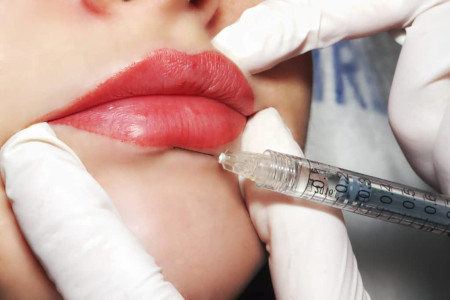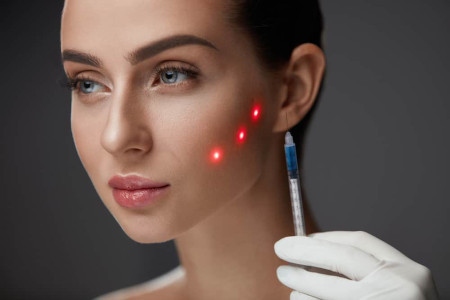Poltava, prospekt Vitaliia Hrytsaienka 9 Weekdays: 8:30-15:00, Weekend: weekend +38 (0532) 56-02-11+38 (095) 688 25 07
Allergy to hyaluronic acid: causes, symptoms and prevention
 Hyaluronic acid is one of the most sought-after products in modern cosmetology. Wanting to improve their appearance without surgery, more and more people choose precisely the beauty injections with its use. The popularity of such drugs is associated with a pronounced aesthetic effect and safety. Indeed, in most cases, injections do not cause any allergic reactions. However, it is impossible to completely eliminate the possibility of allergy. Why does it arise, how does it manifest itself and can it be prevented?
Hyaluronic acid is one of the most sought-after products in modern cosmetology. Wanting to improve their appearance without surgery, more and more people choose precisely the beauty injections with its use. The popularity of such drugs is associated with a pronounced aesthetic effect and safety. Indeed, in most cases, injections do not cause any allergic reactions. However, it is impossible to completely eliminate the possibility of allergy. Why does it arise, how does it manifest itself and can it be prevented?
Causes of allergic reactions
Allergy after the administration of preparations based on hyaluronic acid can occur for several reasons:
- tendency to allergic reactions in case of ingestion of any foreign substances;
- allergy to painkillers that are used before the injection;
- individual intolerance to fillers, which include synthetic hyaluronic acid;
- allergy to certain components of drugs peptides, vitamins;
- poor quality fillers and the presence of impurities;
- non-compliance with the rules of use of the drug;
- the presence of contraindications to cosmetic injections.
Previously, one of the most common causes of allergy was the use of hyaluronic acid products of animal origin. It could not be completely cleaned of lipid and protein compounds, which were the main causes of unwanted allergic reactions after the procedures. Today, among conscientious cosmetologists, it is not customary to use it. Professionals prefer hyaluronic acid derived from a vegetable substrate with the use of special bacteria. It has a high degree of purification, which minimizes the risk of allergic reactions.
Symptoms of allergies to fillers
Injection lip augmentation and other cosmetic procedures with the use of Hayuronic acid has the standard symptoms of the reactions: swelling and reddening of drug administration zones. Symptoms usually appear in the early rehabilitation period and disappear 3-5 days after the injections. Fearing these familiar symptoms do not they do not carry any danger.
But there are a number of symptoms, the appearance of which indicates the development of allergy to hyaluronic acid:
- severe itching and severe burning in the areas of filler injections;
- rash with parallel swelling of the skin;
- severe swelling that does not go away even 3-5 days after the procedure;
- discoloration of the skin and the appearance of age spots;
- the occurrence of herpes.
 With all these symptoms, you must consult a doctor. He will prescribe diagnostic procedures to refute or confirm allergies. If the diagnosis is confirmed, after finding out the causes of adverse reactions, the specialist will prescribe a treatment.
With all these symptoms, you must consult a doctor. He will prescribe diagnostic procedures to refute or confirm allergies. If the diagnosis is confirmed, after finding out the causes of adverse reactions, the specialist will prescribe a treatment.
Even if the allergy did not provoke serious negative consequences, it is not recommended to reuse the same drug. Ingestion of the same allergic component in the body can cause severe systemic reactions. Therefore, after treatment, the doctor will determine which means with hyaluronic acid can be used later on for a specific patient, and which ones should be discarded.
Prevention of Allergy to Hyaluronic Acid
To prevent potential allergies to fillers, allergy tests should be carried out before the injection procedures. To do this, small scratches are made on the skin, on top of which a possible irritant is applied based on hyaluronic acid, which is planned to be used during the operation. If after 2-3 days no warning symptoms appear, then the use of the drug is acceptable.
In order for the introduction of fillers to pass for a patient with minimal risks, it is necessary to follow a few simple rules:
- If the patient has a predisposition to allergies to various cosmetic means, it is recommended to use antihistamines. They need to be taken 3-4 days before and after the procedure.
- The first day after the procedure can not have any physical effects on the treatment area.
- A few days before and after the session should not drink alcohol, as well as spicy and salty foods.
- For two weeks after the injection, it is advisable not to visit the baths, saunas and solariums.
And most importantly, after the procedure, you need to follow all the recommendations of the doctor. This ensures quality post-operative recovery.
specialists of the Clinic for Plastic Surgery
28-06-2019
Similar news
